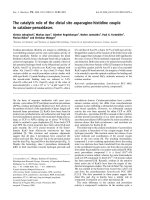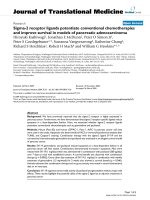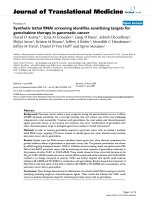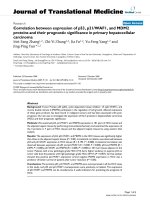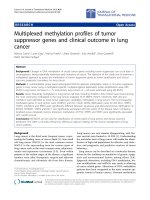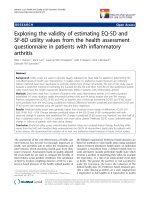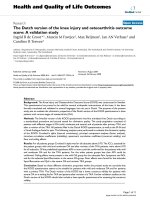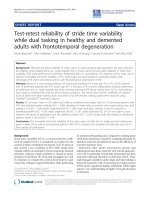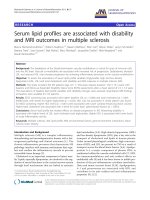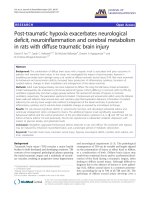Báo cáo hóa học: " Multiplexed methylation profiles of tumor suppressor genes and clinical outcome in lung cancer" potx
Bạn đang xem bản rút gọn của tài liệu. Xem và tải ngay bản đầy đủ của tài liệu tại đây (1.08 MB, 11 trang )
RESEARC H Open Access
Multiplexed methylation profiles of tumor
suppressor genes and clinical outcome in lung
cancer
Mónica Castro
2
, Laura Grau
1
, Patricia Puerta
1
, Liliana Gimenez
2
, Julio Venditti
3
, Silvia Quadrelli
3
,
Marta Sánchez-Carbayo
1*
Abstract
Background: Changes in DNA methylation of c rucial cancer genes including tumor suppressors can occur early in
carcinogenesis, being potentially important early indicators of cancer. The objective of this study was to examine a
multiplexed approach to assess the methylation of tumor suppressor genes as tumor stratification and clinical
outcome prognostic biomarkers for lung cancer.
Methods: A multicandidate probe panel interrogated DNA for aberrant methylation status in 18 tumor suppressor
genes in lung cancer using a methylation-specific multiplex ligation-dependent probe amplification assay (MS-
MLPA). Lung cancer cell lines (n = 7), and primary lung tumors (n = 54) were examined using MS-MLPA.
Results: Genes frequently methylated in lung cancer cell lines including SCGB3A1, ID4, CCND2 were found among
the most commonly methylated in the lung tumors analyzed. HLTF, BNIP3, H2AFX, CACNA1G, TGIF, ID4 and
CACNA1A were identified as novel tumor suppressor candidates methylated in lung tumors. The most frequently
methylated genes in lung tumors were SCGB3A1 and DLC1 (both 50.0%). Methy lation rates for ID4, DCL1, BNIP3,
H2AFX, CACNA1G and TIMP3 were significantly different between squamous and adenocarcinomas. Methylation of
RUNX3, SCGB3A1, SFRP4, and DLC1 was significantly associated with the extent of the disease when comparing
localized versus metastatic tumors. Moreover, methylation of HTLF, SFRP5 and TIMP3 were significantly associated
with overall survival.
Conclusions: MS-MLPA can be used for classification of certain types of lung tumors and clinical outcome
prediction. This latter is clinically relevant by offering an adjunct strategy for the clinic al management of lung
cancer patients.
Background
Lung cancer is the third most frequent tumor, repre-
senting the leading cause of cancer death [1]. Non-small
cell lung cancer (NSCLC) is the most common variant.
NSCLC is the superseding term for various types of
lung cancer such as the most common ones, adenocarci-
nomas and squamous carcinomas [2-4]. Even within
patients at the earliest stages of the disease, a significant
number recur after therapeutic surgery and adjuvant
chemotherapy, and ultimately die from the ir disease.
Lung cancer cure rate remains disappointing, with five-
year survi val rates limited to 15-20% [1]. Understanding
the molecular basis of lung cancer will enable the identi-
fication of high-risk populations for effective early detec-
tion, and prognostic and predictive markers of t umor
behaviour.
Lung cancer can be de scribed as a molecular disease,
driven by the multistep accumulation of genetic, epige-
netic and environmental factors, among others [5,6].
Epigenetic alterations, including DNA methylation, his-
tone modification s, and miRNAs may result in silencing
of cancer-related genes. Alterations of DNA methylation
patterns have been recognized as the most common epi-
genetic even ts in human cancers. Aberrant methylation
* Correspondence:
1
Tumor Markers Group, Molecular Pathology Program, Spanish National
Cancer Center, Madrid, Spain
Full list of author information is available at the end of the article
Castro et al. Journal of Translational Medicine 2010, 8:86
/>© 2010 Castro et al; licensee BioMed Central Ltd. This is an Open Access article distributed under the terms of the Creative Co mmons
Attribution Lice nse (http://creativecommo ns.org/licens es/b y/2.0), which permits unrestricted use, distribution, and reproduction in
any medium, provided the original work is properly cited.
of normally unmethylated CpG-rich areas, also known
as CpG islands, located in or near the p romoter region
of many genes, has been associated with the initiation
and progression of several types of cancer [7-11]. In
NSCLC, transcriptional inactivation of important tumor
suppressor, DNA repair, and metastasis inhibitor genes,
among others, has been reported [2,12]. Therefore, the
detection of aberrant promoter methylation of cancer-
related genes may be essential for the diagnosis, prog-
nosis and/or detection of metastatic pot ential of tumors,
including lung cancer. As the number of genes methy-
lated in cancer is large and increasing, sensitive and
robust multiplexed methods for detecting of aberrant
methylation of promoter regions are therefore, desirable.
Historically, the molecular pathogenesis of cancer has
been analyzed one gene at a time. CpG arrays represent
a high-throughput technology accelerating the discovery
of genes frequently hypermethylated during disease pro-
gression, also for lung cancer [13,14]. Methylation speci-
fic multiplex ligation-dependent probe amplification
(MS-MLPA) is a PCR-based technique allowing the
semiquantitative detection of changes in DNA promoter
methylation of multiple genes in a single experiment
[15,16]. Discrimination between methylated and
unmethylated targets is based on the annealing of
probes containing a recognition site for the methylation-
sensitive restriction enzyme HhaI. MS-MLPA has been
applied to the multiplexed measurement of methylated
genes in several diseases, including cancer [17-28]. Its
potential utility in lung cancer has not been character-
ized. In this study, we initially assessed, by MS-MLPA,
whether a selected panel of candidate tumour suppres-
sor genes could be methylated in lung cell lines and
tumors. Next, we determined whether the methylation
status of such genes could contribute for l ung tumor
stratification and clinical outcome prognosis.
Methods
Lung cancer cell lines
Six NSCLC cell lines consisting of three adenocarci-
noma cell lines (A549, H522 and H358), two large carci-
noma cell lines (H460, H661), and one squamous cell
carcinoma cell line (H226), as well as one small cell
lung cancer cell line (SCLC) (H841) were obtained from
the American Type Culture Col lection (Rockville, MD,
US), grown in RPMI-1640 medium (Sigma) supplemen-
ted with 10% fetal bovine serum, and collected under
standard tissue culture protocols. The lung cancer cell
line, H460, was included in all sample runs in order to
test the reproducibility of the MS-MLPA test.
Tumor samples
The study cohort con sisted of a series of archived paraf-
fin-embedded blocks from 54 NSCLC patients. Patients
with local disease (stage I to resectable stage III) were
treated surgically and those with advanced disease (stage
III and IV) received systemic and/or local treatment.
Primary lung tumors were collected after institutional
review board approval and handled anonymously follow-
ing ethical and legal protection guidelines of human
subjects. The observation period ranged from 2 to
79 months, with a median follow-up of 20,5 months.
Inclusion criteria of newly diagnosed lung cancer
patients were based on the histopathologic information,
covering from early to advanced stages. It was also
required to have tissue material available for obtaining
high-quality DNA for methylation analyses. Of the 54
NSCLC patients, 22 had TNM Stage I-II, 18 had Stage
III, and 14 stage IV defined under standard criteria [29].
The tumors w ere histologically classified as adenocarci-
nomas (n = 32), squamous cell carcinomas (n = 21) and
large cell carcinoma (n = 1) according to the histological
typing of lung tumors of the World Health Organization
[29]. Demographic and clinicopathologic information of
the lung cases analyzed is described in Table 1.
Table 1 Demographic and clinicopathologic information
of the lung cases analyzed
Clinical Parameters Cases n (%)
Age ≥65 28 (51.9%)
<65 26 (48.1%)
Gender Male 37 (68.5%)
Female 17 (31.5%)
Smoking history Yes 46 (85%)
No 6 (11%)
Unknown 2 (3%)
Karnosfsky ≥80 45 (83.3%)
<80 9 (16.7%)
Histology Squamous Cell Carcinoma 21 (38.5%)
Adenocarcinoma 32 (59.6%)
Large Cell Carcinoma 1 (1.9%)
Differentation grade Good differentiated 11 (20.4%)
Moderate 16 (29.6%)
Poor 27 (50%)
Stage I-II 22 (40.7%)
III 18 (33.3%)
IV 14 (26%)
Local/Advanced Local (stage I II) 22 (40.7%)
Advanced (stage III-IV) 32 (59.3%)
Progression Yes 26 (48.1%)
No 28 (51.9%)
Death Yes 25 (46.3%)
No 29 (53.7%)
Summary of the distribution of the following variables among patients
studied: age, gender, smoking history, Karnofsky status, histology,
differentiation grade, stage, extension of disease, and the number of cases
progressing or dying of the disease during the study.
Castro et al. Journal of Translational Medicine 2010, 8:86
/>Page 2 of 11
DNA extraction
Genomic DNA from cell lines and tissue was extracted
using standard methods. Paraffin-embedded tissues
were macro-dissected based on hematoxylin-eosin eva-
luations to ensure a minimum of 75% of tumor cells
[30]. Corresponding slides were digested using protei-
nase K (Roche Diagnostics GmbH, Mannheim,
Germany) overnigh t before DNA extraction. Concentra-
tion and purity of DNA samples were determined with
a ND-1000 sp ectrophotometer (NanoDr op Technolo-
gies, Wilmington, DE, USA). DNA quality was evalu-
ated based on 260/280 ra tios of absorbances and the
integrity was also checked by gel electrophoresis analy-
sis using the Agilent 2100 B ioanalyzer (Agilent Tech-
nologies, Palo Alto CA).
Methylation-Specific Multiplex Ligation-Dependent Probe
Amplification (MS-MLPA)
The present study used the MS-MLPA probe set ME003
(MRC-Holland, Amsterdam, The Net herlands) which
can simultaneously check for aberrant methylation at
one or two CpG dinucleotides of the following proven
or suspected 18 tumor suppressor genes (Table 2).
Probe sequences, gene loci and chromosome locations
can be found at (date of acce s-
sion: 25-May-2010). Several genes were evaluated by
two probes, which recognized different Hha1 restriction
sites in their promoter regions. The experimental proce-
dure was carried out and results analyzed according to
the manufacturer’s instructions, with minor modifica-
tions. In short, DNA (200 ng) was dissolved up to 5 μl
Table 2 Information of the tumor suppressor genes analyzed
Gene Name
a
Probes Functional implications Chromosomal
Localization
b
PRDM2 PR domain containing 2, with ZNF domain 09146-L02862 Cell cycle control 1p36
RUNX3 Runt-related transcription factor 3 11131-L03905 TGFB signaling 1p36
RARB Retinoic acid receptor beta 10362-L10900 Cell differentiation and
proliferation
3p24
HLTF Helicase-like transcription factor 09152-L09384(probe 1) 02758-
L02207(probe 2)
Transcription regulation 3q25.1-q26.1
SCGB3A1 Secretoglobin, family 3A, member 1 03305-L09382 (probe1) 11132-
L12956(probe 2)
Cell differentiation and
proliferation
5q35-qter
ID4 Inhibitor of DNA binding 4, dominant negative
helix-loop-helix protein
04497-L03909(probe 1) 04496-
L03908(probe 2)
Transcription regulation 6p22.3
TWIST1 Twist homolog 1 (Drosophila) 02080-L02886 Cell differentiation and
proliferation
7p21
SFRP4 Secreted frizzled-related protein 4 03744-L03204(probe 1) 09147-
L03205(probe 2)
WNT antagonism 7p14.1
DLC1 Deleted in liver cancer 1 02754-L02203(probe 1) 02753-
L02202(probe 2)
Cell differentiation and
proliferation
8p22
SFRP5 Secreted frizzled-related protein 5 09149-L03207(probe 1) 09148-
L12957(probe 2)
WNT antagonism 10q24
BNIP3 BCL2/adenovirus E1B 19kDa Interacting protein 3 07138-L12958 Proliferation and
apoptosis
10q.26.3
H2AFX H2A histone family, member X 08511-L08607(probe 1) 08509-
L08605(probe 2)
Transcription regulation 11q23.3
CCND2 Cyclin D2 03313-L02668(probe 1) 03312-
L09381(probe 2)
Cell cycle control 12p13
CACNA1G Calcium channel, voltage-dependent, T type, alpha
1G subunit
10123-L10466 Cell differentiation and
proliferation
17q22
TGIF TGFB-induced factor homebox 1 02850-L13256 TGFB signaling 18p11.31
BCL2 B-cell CLL/lymphoma2 10352-L10890 Proliferation and
apoptosis
18q21.3
CACNA1A Calcium channel, voltage-dependent, P/Q type,
alpha 1A subunit
09055-L09224 Cell differentiation and
proliferation
19p13
TIMP3 TIMP metallopeptidase inhibitor 3 10357-L10895(probe 1) 10354-
L10892(probe 2)
Invasion and metastasis 22q12.3
Summary of the gene description, probes, functional implications, and chromosomal location of the tumor suppressor genes analyzed in this study.
Gene names in bold highlight novel candidates never reported to be met hylated in lung cancer to date. a. Human Genome Organization Nomenclature;
b. Approved gene name from Human Genome Organization available at />Castro et al. Journal of Translational Medicine 2010, 8:86
/>Page 3 of 11
TE-buffer (10 mM Tris pH 8.2, 1 mM EDTA pH 8.0),
dena tured and subsequently cooled down to 25°C. After
adding the probe mix, the probes were allowed to hybri-
dize (16 h at 60°C). Subsequently, the samples were
divided in two: one half of the samples were ligated,
whereas for the other part of the samples, ligation was
combined with the HhaI digestion enzyme. This diges-
tion resulted in ligation of only the methylated
sequences. PCR was performed on both parts of the
samples in a volume of 50 μl containing 10 μlofthe
ligation reaction mixture using a thermal cycler (MJ
Research Inc., Waltham, MA, US A), with 35 cyc les of
denaturation at 95°C for 30 s, annealing at 60°C for 30 s
and extension at 72°C for 1 min with a final extension
of 20 min at 72°C. Aliquots of 2 μl of the PCR reaction
were combined with 0.12 μl LIZ-labeled internal size
standard (Applied Biosystems, Foster City, CA, USA)
and 9.0 μl deionized formamide. After denaturation,
fragments were separated and quantified by electrophor-
esis on an ABI 3700 capillary sequencer and the Peak
Scanner v1.0 analysis software (both Applied Biosys-
tems). Peak identification and values corresponding to
peak size in base pairs (bp), and peak areas were used
for further data processing. Automated fragment and
data analysis was performed exporting the peak areas to
an excel-based analysis program (Coffalyser V8, MRC-
Holland). For hypermethylation analysis the ‘relative
peak value’ or the so-called ‘probe fraction’ of the liga-
tion-digestion sample is divided by the ‘relative peak
value’ of the corresponding ligation (undigested) sample,
resulting in a so-called ‘ methylation-ratio’ (M-ratio).
Aberrant methylation was sc ored when the calculated
M-ratio was ≥0.30, corresponding to 30% of methylated
DNA. The methylated ratios were interpreted as absence
of hy permethylation (0.00-0.29), mild hypermethylation
(0.30-0.49), moderate hypermethylation (0.50-0.69), and
extensive hypermethylation (>0.70). In genes with more
than one p robe, their ratios were calculated indepen-
dently for methylation analysis.
Statistical Analysis
Coefficients of variation for each probe were estimated
based on the ratio of the standard deviation and the
respective mean of four replicates of the H460 cell line.
Associations among MS-MLPA methylation and tumor
stageandgradewereevaluated using non-parametric
Wilcoxon-Mann-Whitney and K ruskall-Wallis tests
using Bonferroni adjustment for multiple testing. Asso-
ciations between methylation candidates were analyzed
using Kendall’s tau ß test, considering only two-sided
p-values 0.05 to be statistically significant. For each
probe of the assay, methylation was scored when the
calculated M-ratio was ≥0.30. Associations of methyla-
tion of each gene probe with overall survival were also
evaluated using the log-rank test in those cases for
which follow-up information were available. Overall sur-
vival time was defined as the months elapsed between
surgery a nd death as a result of disease (or the last fol-
low-up date). Patients who were alive at the last follow-
up or lost to follow-up were censored. Survival curves
were plotted using the s tandard Kaplan-Meier metho-
dology [31]. Statist ical analyses were performed using
the SPSS statistical package (SPSS 17.0.1 for Windows
2009, Chicago, IL, USA).
Results
Quality assessment of MS-MLPA assay
In order to test the reproducibility of the assay, a lung
cancer cell line, H460, was included as control samples
each assay run. The methylation ratios of these repli-
cated experiments of the cell line analyzed and their
coefficients of variation are shown in additional file 1,
Table S1. Using the thresholds defined above for methy-
lation detection suggested high reproducibility of the
methylation profiles. In conclusion, these initial analyses
revealed reproducible results allowing methylation
assessment using the selected panel of candidate genes.
MS-MLPA profiles of lung cancer cell lines
The methylation profiles of the 18 genes under study
were initially tested in seven cell lines derived from lung
tumors of different histopathologic variants. Additional
file 2, Table S2 provides an overview of the methylation
patterns o f these cell lines grouped based on the histo-
pathology of the tumors from which these lung cancer
cell lines were derived from. The percentual methylation
for each gene is provided as well. Several genes:
SCGB3A1, ID4, SFRP5, CCND2, and CACNA1A, were
found methylated in at least 4 out of the 7 cell lines
analyzed, covering various histopathologic type s. These
initial analyses suggested that the panel of candidate
genes selected c ould be appropriate to detect aberrant
methylation profiles in human lung tumors.
MS-MLPA profiles for clinico-histopathologic stratification
of lung tumors
In the next step, we tested whether MS-MLPA could be
applied to lung tumors (Figure 1, Table 3). Overall, the
most frequent hypermethylated genes found by MS-
MLPA were DLC1 (50%), SCGB3A1 (50.0%), CCND2
(48.1%), ID4 ( 46.3%), BNIP3 (44.4%), RUNX3 (42.5%),
and PRDM2 (40.7%). Notably, genes methylated in lung
tumor specimens frequently overlapped with those
found to be methylated in the lung cancer cell lines as
shown above. Promoter hypermethylation of genes pre-
viously reported methylated in lung cancer included
PRDM2, RUNX3, RARB, SCGB3A1, TWIST1, SFRP4,
DLC1, SFRP5, CCND2, BCL2 and TIMP3 (Reviewed in
Castro et al. Journal of Translational Medicine 2010, 8:86
/>Page 4 of 11
additional file 3, Table S3). Methylation was newly iden-
tified for HLTF, ID4, BNIP3, H2AFX, CACNA1G, CAC-
NA1A, and TGIF. The percentual methylation rates of
each gene depending on the different clinicopathologic
variables are shown in Table 3. The genes more fre-
quently methylated in adenocarcinomas were: RARB,
TWIST1, and CACNA1A, while the most commonly
methylated genes in squamous tumors w ere SCGB3A1,
ID4, SFRP4, SFRP5, DCL1, BNIP3, H2AFX , CACNA1G,
TGIF, TIMP3 and BCL2. Statistically significantly differ-
ent methylation rates were observed for ID4-2 (p =
0.011), DCL1 (p = 0.019), BNIP3 (p = 0.003), H2AFX (p
= 0 .001), H2AFX-2 (p = 0.005), CACNA1G (p = 0.007)
and TIMP3 (p = 0. 021) when comparing squamous ver-
sus adenocarcinoma cases. When comparing methyla-
tion rates in localized tumors versus metastatic disease,
the methylation of RUNX3 (p = 0.013), SCGB3A1-2 (p
= 0.008), SFRP4-2 (p = 0.022), and DLC1 (p = 0.016)
was significantly associated with the presence of meta-
static disease. The methylation of the same genes was
also associated with tumor stage RUNX3 (p = 0.040),
SCGB3A1 (p = 0.032), SFRP4 (p = 0.033), and DLC1
(p = 0.035). RARB methylation (p = 0.028) was asso-
ciated with the Karnofsky status. Methylation of several
genes was simultaneously present in the lung tumors
analyzed, as revealed by Kendall’ s tau correlations
shown in additional f ile 4, Table S4. We did not find
any significant association between methylation of t he
genes under study and age, gender, smoking hi story
(data no t shown). Methylation rates regarding histology
lung subtypes, differentiation grade and tumor stage
(comparing localized versus advanced disease), are pro-
vided in Table 3. In conclusion, this set of analys es sug-
gested that the panel of candidate gen es selected could
be of clinical relevance for the clinicopathologic staging
of human lung tumors.
MS-MLPA profiles for clinical outcome prognosis for lung
cancer patients
In the next step, we tested whether MS-MLPA could be
applied to differentiat e patients with different clinical
outcome, using overall survival as the clinical endpoint.
We observed that patients with tumors methylated for
the HTLF gene showed an overall survival significantly
shorter as compared to patients unmethylated for HTLF
(log rank, p = 0.035; Figure 2A). In contrast, survival
was significantly longer in patients with methyl ation for
SFRP5(probe2)(logrank,p=0.021;Figure2B);and
Figure 1 Methylation profiles of lung tumors. The methylated ratios were interpreted as absence of hypermethylation (0.00-0.29), highlighted
as white cells; mild hypermethylation (0.30-0.49) highlighted as light grey cells; moderate hypermethylation (0.50-0.69), highlighted as medium
grey cells; and extensive hypermethylation (0.70-1.00), highlighted as dark grey cells. Gene names in bold highlight novel candidates never
reported to be methylated in lung cancer to date. Advanced tumors are highlighted with dots. LC: large cell carcinomas.
Castro et al. Journal of Translational Medicine 2010, 8:86
/>Page 5 of 11
TIMP3 (log rank, p = 0.030; Figure 2C), as compared to
patients with no aberrant me thylation of these genes.
Importantly, this set of analyses indicated that the
methylation of three genes was significantly associated
with overal l survi val, suggesting that the panel of candi-
date genes under analyses could b e of clinical relevance
as prognosticators of the clinical outcome of patients
affected with lung tumors.
Discussion
The present study evaluates the application of a multi-
plexed methylation technique in lung cancer. MS-MLPA
was initially tested in cell lines and tissue specimens
representing different steps of lung cancer progression
supporting the panel of the tumor suppressor genes
selected to be altered in lung cancer. In this study, we
included genes with important roles in cell cycle control
(PRDM2, CCND2), transcri ption regulation (HTLF, ID4,
H2AFX), TGF-b signaling (RUNX3, TGIF), WNT antag-
onism (SFRP4, SFRP5), cell differentiation and prolifera-
tion (SCGB3A1, TWIST1, RARB, CACNA1A,
CACNA1G, DLC1), proliferation and apoptosis (BNIP3,
BCL2), and invasion and metastasis (TIMP3). Our pre-
sent data is in co ncordance with previous reports show-
ing altered methylation patterns in lung cancer in genes
such as PRDM2 [32], RUNX3 [33-38], RARB [37,39-41],
SCGB3A1 [ 42,43], TWIST1 [44], DLC1 [45,46], SFRP4
[36,44], SFRP5 [36,38,44,47], CCND2 [40,41,48,49],
BCL2 [50] and TIMP3 [14,46,51]. Importantly, our
study identified seven novel methylated candidates in
Table 3 Summary of the frequency of methylation of the genes in lung tumors based of their main clinicopathologic
variables
Gene Overall (%) Histology (%) Differentation Grade (%) Tumor stage (%)
Methylation n = 54 SCC n = 21 ADC n = 32 Good n = 11 Moderate n = 16 Poor n = 27 Local n = 22 Advanced n = 32
PRDM2 22 (40.7) 10 (45.4) 12 (37.5) 21 (45.6) 0 (0) 12 (44.4) 10 (45.4) 12 (37.5)
RUNX3 23 (42.5) 13 (59.1) 10 (31.2) 19 (41.3) 2 (33.3) 10 (37.0) 13 (59.1) 10 (31.2)
RARB 20 (37) 8 (36.4) 12 (37.5) 17 (36.9) 3 (50.0) 10 (37.0) 8 (36.4) 12 (37.5)
HLTF 8 (14.8) 1 (4.5) 7 (21.9) 8 (17.4) 0 (0) 7 (25.9) 1 (4.5) 7 (21.9)
HLT-2 17 (31.5) 9 (40.9) 8 (25.0) 14 (30.4) 2 (33.3) 10 (37.0) 9 (40.9) 8 (25.0)
SCGB3A1 27 (50.0) 15 (68.2) 12 (37.5) 24 (52.2) 2 (33.3) 15 (55.5) 15 (68.2) 12 (37.5)
SCGB3A1-2 17 (31.5) 12 (54.5) 5 (15.6) 12 (26.0) 4 (66.7) 9 (33.3) 12 (54.5) 5 (15.6)
ID4 25 (46.3) 12 (54.5) 13 (40.6) 23 (50.0) 1 (1.7) 12 (44.4) 12 (54.5) 13 (40.6)
ID4-2 11 (20.4) 5 (22.7) 6 (18.7) 10 (21.7) 1 (1.7) 7 (25.9) 5 (22.7) 6 (18.7)
TWIST1 21 (38.9) 9 (40.9) 12 (37.5) 19 (41.3) 2 (33.3) 10 (37.0) 9 (40.9) 12 (37.5)
SFRP4 10 (18.5) 7 (31.8) 3 (9.4) 9 (19.5) 1 (1.7) 5 (18.5) 7 (31.8) 3 (9.4)
SFRP4-2 16 (29.6) 11 (50.0) 5 (15.6) 12 (26.0) 3 (50.0) 8 (29.6) 11 (50.0) 5 (15.6)
DLC1 22 (40.7) 12 (54.5) 10 (31.2) 18 (39.1) 3 (50.0) 13 (48.1) 12 (54.5) 10 (31.2)
DLC1-2 27 (50.0) 15 (68.2) 12 (37.5) 21 (45.6) 5 (83.3) 14 (51.8) 15 (68.2) 12 (37.5)
SFRP5 17 (31.5) 8 (36.4) 9 (28.1) 15 (32.6) 2 (33.3) 10 (37.0) 8 (36.4) 9 (28.1)
SFRP5-2 12 (22.2) 6 (27.3) 6 (18.7) 9 (19.6) 2 (33.3) 8 (29.6) 6 (27.3) 6 (18.7)
BNIP3 24 (44.4) 12 (54.5) 12 (37.5) 20 (43.5) 2 (33.3) 13 (48.1) 12 (54.5) 12 (37.5)
H2AFX 10 (18.5) 5 (22.7) 5 (15.6) 9 (19.5) 1 (1.7) 6 (22.2) 5 (22.7) 5 (15.6)
H2AFX-2 9 (16.7) 6 (27.3) 3 (9.4) 8 (17.4) 1 (1.7) 5 (18.5) 6 (27.3) 3 (9.4)
CCND2 26 (48.1) 13 (59.1) 13 (40.6) 22 (47.8) 3 (50.0) 15 (55.5) 13 (59.1) 13 (40.6)
CCND2-2 29 (53.7) 14 (63.6) 15 (46.9) 25 (54.3) 4 (66.7) 15 (55.5) 14 (63.6) 15 (46.9)
CACNA1G 21 (38.9) 12 (54.5) 9 (28.1) 19 (41.3) 1 (1.7) 12 (44.4) 12 (54.5) 9 (28.1)
TGIF 10 (18.5) 5 (22.7) 5 (15.6) 9 (19.5) 1 (1.7) 6 (22.2) 5 (22.7) 5 (15.6)
BCL2 8 (14.8) 4 (18.2) 4 (12.5) 8 (17.4) 0 (0) 5 (18.5) 4 (18.2) 4 (12.5)
CACNA1A 18 (33.3) 11 (50.0) 7 (21.9) 13 (28.3) 4 (66.7) 8 (29.6) 11 (50.0) 7 (21.9)
TIMP3 10 (18.5) 7 (31.8) 3 (9.4) 9 (19.6) 1 (1.7) 5 (18.5) 7 (31.8) 3 (9.4)
TIMP3-2 11 (20.4) 7 (31.8) 4 (12.5) 9 (19.6) 1 (1.7) 6 (22.2) 7 (31.8) 4 (12.5)
The number of samples (n) displaying a methylation ratio higher than 0.3, as well as their percentual frequency within each group of specimens under analyses
was included.
Highlighted genes in bold represented novel candidates never reported methylated in lung cancer to date. Ys: years; SCC: squamous cell carcinoma; ADC:
adenocarcinoma.
Castro et al. Journal of Translational Medicine 2010, 8:86
/>Page 6 of 11
lungcancer,includingHLTF,ID4,BNIP3,H2AFX,
CACNA1G, CACNA1A and TGIF. The clinical outcome
of the patients whose tumors were analyzed using this
technique revealed that individual tumors behaved
according to histopathologic staging and also to their
methylation patterns analyzed using this type of multi-
plexed strategy. The MS-MLPA approach thereby
offered an opportunity to test and improve histopatholo-
gic stratification and also prognostic statements. This
latter is clinically relevant since it offers an altern ative
adjunct strat egy for the clinic al managem ent of patients
affected with lung cancer.
Among the high-throughput techniques available
today for epigenetic alterations assessment, the CpG
array represents the main comprehensive platform
already applied to identify methylation candidates in
lung cancer [13,1 4]. To our knowledge, the multiplexed
MS-MLPA technique has not been employed t o analyze
the methylation profiles in lung cancer. The advantages
of MS-MLPA technique as an alternative for MS-PCR
include: allowing screening of multiple predefined pro-
moter methylation candidates in one experiment using a
low amount of DNA (100-200 ng), being feasible using
DNA extracted from tissue (even in formalin fixed
material), providing semiquant itative data, and requiring
only standard laboratory equipment. Furthermore, the
(potentially) troublesome bisulfite conversion of
unmethylated cytosines required for MS-PCR can be
omitted in MS-MLPA using a methylation-sensitive
digestion. Methylation indices for the majority of the
probes under study were consistent and reproducible.
Overall, the variation of the methylation ratios obtained
for e ach probe revealed inter-assay reproducibility reli-
able enough for clinical practice.
Figure 2 Methylat ion profiles as clinical out come prognosticat ors for lung cancer patients. A) K aplan-Mayer curve s urvival analysis
indicating that tumors methylated for HTLF showed poor survival than those unmethylated for this gene (log rank, p = 0.035). B) Kaplan-Mayer
curve survival analysis indicating that tumors methylated for SFRP5-2 (probe 2) showed better survival than those unmethylated for this gene
(log rank, p = 0.021). C) Kaplan-Mayer curve survival analysis indicating that tumors methylated for TIMP3 showed better survival than those
unmethylated for this gene (log rank, p = 0.030).
Castro et al. Journal of Translational Medicine 2010, 8:86
/>Page 7 of 11
The identifi cation of the different methylation profi les
in lung cancer cell lines provided first insights of the
potential impact of these candidate genes for human
lung cancer. Results of the tumor s et for the to p differ-
entiating genes concurred with the main MS-MLPA
results in the cells set (supporting the cancer specificity
of the methylated candidates), and also with previous
reports describing methylation for some of the candi-
dates under study, such as PRDM2 [32], RUNX3
[35,36], SFRP4 and SFRP5 [36], S CGB3A1 [43], DLC1
[46], CCND2 [48]. In our series, RUNX3 [33-35,38],
SCGB3A1 [43], CCND2 [49] exhibited higher methyla-
tion rates as compared to these reports; whereas SFRP4
andSFRP5[44],DLC1[45],TIMP3[51]showedlower
methylation rates than previous studies. In addition to
the inter-individual variation, these differences could be
attributed to several issues: 1) it is important to be
aware that aberrant methylation needs to meet the cut-
off ratio of 30% or greater set by the mathemati cal algo-
rithm designed to distinguish legitimate methylation
peaks. Variation in cutoff setting would render improved
accuracies for each specific gene. 2) Discrepancy in the
frequency of methylation mightbeattributedinpartto
the number and type of stages analyzed. 3) Heterogene-
ity of the promo ter methylation may exist within the
individual gene promoters for certain genes in lung can-
cer carcinomas. MS-MLPA is only based on a single
CpG site compared to an average of 4-6 CpG sites in
MS-PCR assays. Since only a small part of the promotor
is usually analyzed by MS-MLPA, the methylation of
additional of nearby CpG islands cannot be excluded. 4)
Availability of two p robes targeting different CpG
islands with different methylation ratios for two of the
genes analyzed served to highlight the differential
methylation and potential conseq uences of each specific
CpG site within a gene. The relative impact of each site
was observ ed for those genes for which different probes
were included targeting differe nt CpG sites displaying
different methylation rates. 5) MS-MLPA ratios may
potentially be underestimated due to the presence of
normal (U) ‘ contaminating’ cells in the tumor sample.
However, whereas the detection of an unmethylated
promoter next to methylated sequences is usually disre-
garded as originating from normal tissue, it may fre-
quently reflect tumor heterogeneity and the
polyclonality of the tumors regarding hypermethylation.
Despite of not conta ining a lung cancer specific panel
of tumor suppressors, we observed correlation of hyper-
methylation with lung cancer histopathologic variables.
We detected distinct methylation profiles between squa-
mous and adenocarcinomas, in concordance with pre-
vious reports evaluating part of the genes analyzed using
MS-PCR methods [33-37,41-45,48,51]. Among the novel
methylated candidates identified, ID4, BNIP3, H2AFX,
CACNA 1G, TGIF were more frequently methylated in
squamous tu mors, while HTLF and CACNA1A we re
commonly methylated in adenocarcinomas. In ag ree-
ment with previous observations, methylation of
RUNX3 [36,38], SCGB3A1 [42], DLC1 [45] and SFRP4
[36,44], was identified as early events associated with
early differentiation and stage. The presence of different
methylation patterns in different tumor stages supports
the notion that epigenetic events may be involved in
tumor progression, after the accumulation of additional
genomic instability, and other epigenetic and genetic
events [5,36]. Kendall’s tau as sociatio ns revealed the fre-
quent simultaneous methylation of the genes analyzed,
especially for TIMP3 and H2AFX, SFRP5 and HTLF,
and CACNA1G and BNIP3. These observations high-
light how epigenetic regulation impact on different can-
cer genes carrying out critical cell functions in
neoplastic cells. Importantly, the me thylati on of three of
the genes analyzed (HTLF, SFRP5 and TIMP3) was
associated with clinical outcome. Hypermethylation of
HTLF was associated with poor survival, in agreement
with previous studies indicating the silencing of the
gene by methylation predicting colorectal cancer recur-
rence [52]. On the other hand, hypermethylation of
SFRP5 and TIMP3 was associated with improved survi-
val. TIMP3 methylation was also previously found asso-
ciated with better survival in NSCLC [51], and bladder
cancer [53]. These findings are clinically relevant for the
adjunct potential of the methylation assessment of any
of these three to identify lung cancer patients more
likely to show a poor clinical behavior. Since the biology
and the mechanisms by which these genes play a tumor
suppressor role is not fully characterized, and due to the
limited number of cases analyzed, the interpretation of
the prognostic significance of their promoter hyper-
methylation may warrant further investigation.
Conclusions
MS-MLPA allowed identification of a number of new
and possibly interesting epigenetic alterations such as
HLTF,ID4,BNIP3,H2AFX,CACNA1G,CACNA1A
and TGIF genes, serving to gain more insight into the
development of lung carcinomas. This report highl ights
that the identification of aberrant methylation in promo-
ter regions of cancer genes yields important tumor bio-
markers, underscoring a role for epigenet ics in the early
pathogenesis of the major hist ological subtypes of lung
cancer. The innovative applicability of MS-MLPA in the
types of samples analyzed contributed to the further
understandingoflungcancer biology. To what extent
these genes contribute or are functionally involved in
the different steps during tumorigenesis and cancer pro-
gression remains to be determined. These genes would
represent attrac tive targets for cancer therapy, given the
Castro et al. Journal of Translational Medicine 2010, 8:86
/>Page 8 of 11
reversible nature of epigenetic gene silencing. Impor-
tantly, the clinical translational applications of the MS-
MLPA platform using tissue paraffin/embedded material
relate not only to adjunct tumor classification, but also
for clinical outcome prognosis. The general character of
the assay used (with predefined tumor suppressor genes
not necessary specific to any tumor type) suggested the
need to investigate regions that would be more relevant
for lung cancer and to develop targeted tumor-specific
customized MS-MLPA assays. Considering that the
mortality of lung cancer could be greatly reduced
through detection of the disease at the earliest stages, in
the near future, the semiquantitative aspect of MS-
MLPA may prove to play a role not only for clinical
outcome prognosis and risk stratification but may also
aid for early detection and follow-up of lung cancer
patients, and predict therapeutic response.
Additional material
Additional file 1: Table S1: Quality assessment of methylation
profiles: Inter-assay reproducibility including coefficient of variations
among replicates of each probe for the lung control cell line. The
methylated ratios were interpreted as absence of hypermethylation (0.00-
0.29), highlighted as white cells; mild hypermethylation (0.30-0.49)
highlighted as light grey cells; moderate hypermethylation (0.50-0.69),
highlighted as medium grey cells; and extensive hypermethylation (0.70-
1.00), highlighted as dark grey cells. Gene names in bold highlight novel
candidates never reported to be methylated in lung cancer to date.
Additional file 2: Table S2: Methylation profiles of lung cancer cell
lines. The methylated ratios were interpreted as absence of
hypermethylation (0.00-0.29), highlighted as white cells; mild
hypermethylation (0.30-0.49) highlighted as light grey cells; moderate
hypermethylation (0.50-0.69), highlighted as medium grey cells; and
extensive hypermethylation (0.70-1.00), highlighted as dark grey cells.
Gene names in bold highlight novel candidates never reported to be
methylated in lung cancer to date. Cell lines derived from metastatic
tumors are highlighted with dots. SCC: squamous cell carcinoma; LC:
large cell carcinoma; SCLC: small cell lung cancer
Additional file 3: Table S3: Complementary information of the
genes analyzed using MS-MLPA. Review of the functional implications
and methylation studies of the candidate genes analyzed in this study in
lung cancer.
Additional file 4: Table S4: Kendall’s tau correlation coefficients
evaluating associations among the candidate genes. Two sided
significant coefficients are highlighted in grey.
Abbreviations
ADC: adenocarcinoma; BCL2: B-cell CLL/lymphoma 2; BNIP3: BCL2/adenovirus
E1B 19 kDa Interacting protein 3; CACNA1A: Calcium channel, voltage-
dependent, P/Q type, alpha 1A subunit; CACNA1G: Calcium channel, voltage-
dependent, T type, alpha 1G subunit; CCND2: Cyclin D2; DLC1: Deleted in
liver cancer 1; H2AFX: H2A histone family, member X; HLTF: Helicase-like
transcription factor; ID4: Inhibitor of DNA binding 4, dominant negative
helix-loop-helix protein; LC: Large cell carcinoma; MS-MLPA: Methylation-
Specific Multiplex Ligation-Dependent Probe Amplification Assay; NSCLC:
Non-Small Cell Lung Cancer; PRDM2: PR domain containing 2, with ZNF
domain; RARB: Retinoic acid receptor beta; RUNX3: Runt-related transcription
factor 3; SCC: squamous cell carcinoma; SCGB3A1: Secretoglobin, family 3A,
member 1; SCLC: Small Cell Lung Cancer; SFRP4: Secreted frizzled-related
protein 4; SFRP5: Secreted frizzled-related protein 5; TGIF: TGFB-induced
factor homebox 1; TIMP3: TIMP metallopeptidase inhibitor 3; TWIST1: Twist
homolog 1 (Drosophila); Ys: Years.
Acknowledgements
Study supported by a grant (SAF2009-13035) from the Spanish Ministry of
Education and Culture (to Dr Sánchez-Carbayo). The authors would like to
thank all the members of our clinical collaborators at the institutions
involved in this study for their support in facilitating lung cancer specimens
and their clinical follow-up.
Author details
1
Tumor Markers Group, Molecular Pathology Program, Spanish National
Cancer Center, Madrid, Spain.
2
Oncology Department, Instituto Angel H.
Roffo, Buenos Aires, Argentina.
3
Oncology Department, Hospital Británico,
Buenos Aires, Argentina.
Authors’ contributions
MC participated in acquiring clinical and laboratory data, data analysis and
interpretation, and drafted the manuscript. PP and LG participated in
acquiring clinical and laboratory data, data analysis and data interpretation
and drafted the manuscript. LG, JV, and SQ participated in acquiring clinical
samples and follow-up clinical information. MSC participated in study design
and coordination, data analysis and interpretation and final writing of the
manuscript. All authors read and approved the final manuscript.
Competing interests
The authors declare that they have no competing interests.
Received: 2 July 2010 Accepted: 17 September 2010
Published: 17 September 2010
References
1. Jemal A, Siegel R, Ward E, Murray T, Xu J, Thun MJ: Cancer statistics. CA
Cancer J Clin 2009, 59(4):225-49.
2. Herbst RS, Heymach JV, Lippman SM: Lung Cancer. J Med N Engl 2008,
359(13):1367-80.
3. Pérez-Soler R: Individualized therapy in non-small-cell lung cancer: future
versus current clinical practice. Oncogene 2009, 28(Suppl 1):S38-S45.
4. Heller G, Zielinski CC, Zöchbauer-Müller S: Lung cancer: From single-gene
methylation to methylome profiling. Cancer Metastasis Rev 2010,
29(1):95-107.
5. Belinsky SA: Gene promoter hypermethylation as a biomarker in lung
cancer. Nature Cancer Rev 2004, 4(9):707-17.
6. Pfeifer GP, Rauch TA: DNA methylation patterns in lung cancer. Seminars
in Cancer Biology 2009, 19(3):181-187.
7. Costello JF, Fruhwald MC, Smiraglia DJ: Aberrant CpG-island methylation
has non-random and tumour-type-specific patterns. Nat Genet 2000,
24(2):132-8.
8. Esteller M: CpG island hypermethylation and tumor suppressor genes: A
booming present, a brighter future. Oncogene 2002, 21(35):5427-5440.
9. Jones PA, Baylin SB: The fundamental role of epigenetic events in cancer.
Nat Rev Genet 2003, 3(6):415-28.
10. Herman JG, Baylin SB: Gene silencing in cancer in association with
promoter hypermethylation. N Engl J Med 2003, 349(21):2042-2054.
11. Feinberg AP, Ohlsson R, Henikoff S: The epigenetic progenitor origin of
human cancer. Nat Rev Genet 2006, 7(1):21-33.
12. Hu YC, Sidransky D, Ahrendt SA: Molecular detection approaches for
smoking associated tumors. Oncogene 2002, 21(48):7289-97.
13. Rauch T, Wang Z, Zhang X, Zhong X, Wu X, Lau SK, Kernstine KH, Riggs AD,
Pfeifer GP: Homeobox gene methylation in lung cancer studied by
genome-wide analysis with a microarray-based methylated CpG island
recovery assay. Proc Natl Acad Sci USA 2007, 104(13):5527-32.
14. Wang Y, Zhang D, Zheng W, Luo J, Bai Y, Lu Z: Multiple gene methylation
of nonsmall cell lung cancers evaluated with 3-dimensional microarray.
Cancer 2008, 112(6):1325-36.
15. Schouten JP, McElgunn CJ, Waaijer R, Zwijnenburg D, Diepvens F, Pals G:
Relative quantification of 40 nucleic acid sequences by multiplex
ligation-dependent probe amplification. Nucleic Acids Res
2002, 30(12):e57.
16. Nygren AO, Ameziane N, Duarte HM, Vijzelaar RN, Waisfisz Q, Hess CJ,
Schouten JP, Errami A: Methylation-specific MLPA (MS-MLPA):
Castro et al. Journal of Translational Medicine 2010, 8:86
/>Page 9 of 11
simultaneous detection of CpG methylation and copy number changes
of up to 40 sequences. Nucleic Acids Res 2005, 33(14):e128.
17. Worsham MJ, Chen KM, Meduri V, Nygren AO, Errami A, Schouten JP,
Benninger MS: Epigenetic events of disease progression in head and
neck squamous cell carcinoma. Arch Otolaryngol Head Neck Surg 2006,
132(6):668-677.
18. Jeuken JW, Cornelissen SJ, Vriezen M, Dekkers MM, Errami A, Sijben A,
Boots-Sprenger SH, Wesseling P: MS-MLPA: an attractive alternative
laboratory assay for robust, reliable, and semiquantitative detection of
MGMT promoter hypermethylation in gliomas. Lab Invest 2007,
87(10):1055-65.
19. Berkhout M, Nagtegaal ID, Cornelissen SJ, Dekkers MM, van de
Molengraft FJ, Peters WH, Nagengast FM, van Krieken JH, Jeuken JW:
Chromosomal and methylation alterations in sporadic and familial
adenomatous polyposis-related duodenal carcinomas. Mod Pathol 2007,
20(12):1253-62.
20. Henken FE, Wilting SM, Overmeer RM, van Rietschoten JG, Nygren AO,
Errami A, Schouten JP, Meijer CJ, Snijders PJ, Steenbergen RD: Sequential
gene promoter methylation during HPV-induced cervical carcinogenesis.
Br J Cancer 2007, 97(10):1457-64.
21. Chen K, Sawhney R, Khan M, Benninger MS, Hou Z, Sethi S, Stephen JK,
Worsham MJ: Methylation of multiple genes as diagnostic and
therapeutic markers in primary head and neck squamous cell
carcinoma. Arch Otolaryngol Head Neck Surg 2007, 133(11):1131-8.
22. Scott RH, Douglas J, Baskcomb L, Nygren AO, Birch JM, Cole TR, Cormier-
Daire V, Eastwood DM, Garcia-Minaur S, Lapunzina P, Tatton-Brown K,
Bliek J, Maher ER, Rahman N: Methylation-specific MLPA (MS-MLPA)
robustly detects and distinguishes 11p15 abnormalities associated with
overgrowth and growth retardation. J Med Genet 2008, 45:106-113.
23. Hess CJ, Errami A, Berkhof J, Denkers F, Ossenkoppele GJ, Nygren AO,
Schuurhuis GJ, Waisfisz Q: Concurrent methylation of promoters from
tumor associated genes predicts outcome in acute myeloid leukemia.
Leuk Lymphoma 2008, 49(6):1132-41.
24. Ewald C, Hofmann T, Kuhn SA, Deufel T, Beetz C, Kalff R: Methylation-
specific multiplex ligation-dependent probe amplification in
meningiomas. J Neurooncol 2008, 90(3):267-73.
25. Gylling A, Ridanpää M, Vierimaa O, Aittomäki K, Avela K, Kääriäinen H,
Laivuori H, Pöyhönen M, Sallinen SL, Wallgren-Pettersson C, Järvinen HJ,
Mecklin JP, Peltomäki P: Large genomic rearrangements and germline
epimutations in Lynch syndrome. Int J Cancer 2009, 124(10):2333-40.
26. Buyru N, Altinisik J, Ozdemir F, Demokan S, Dalay N: Methylation profiles in
breast cancer. Cancer Invest 2009, 27(3):307-12.
27. Röhrs S, Dirks WG, Meyer C, Marschalek R, Scherr M, Slany R, Wallace A,
Drexler HG, Quentmeier H: Hypomethylation and expression of BEX2,
IGSF4 and TIMP3 are indicative of MLL translocations in acute myeloid
leukemia. Mol Cancer 2009, 8 :86.
28. Berginc G, Bracko M, Glavac D: MS-MLPA reveals progressive age-
dependent promoter methylation of tumor suppressor genes and
possible role of IGSF4 gene in colorectal carcinogenesis of microsatellite
instable tumors. Cancer Invest J 2010, 28(1):94-102.
29. Brambilla E, Travis WD, Colby TV, Corrin B, Shimosato Y: The new World
Health Organization classification of lung tumours. Eur Respir J 2001,
18(6):1059-1068.
30. Aleman A, Adrien L, Lopez-Serra L, Cordon-Cardo C, Esteller M, Belbin TJ,
Sanchez-Carbayo M: Identification of DNA hypermethylation of SOX9 in
association with bladder cancer progression using CpG microarrays. Br J
Cancer 2008, 98(2):466-73.
31. Dawson-Saunders B, Trapp RG: Basic & Clinical Biostatistics. Norwalk,
Connecticut, Appleton & Lange, 2 1994.
32. Du Y, Carling T, Fang W, Piao Z, Sheu JC, Huang S: Hypermethylation in
human cancers of the RIZ1 tumor suppressor gene, a member of a
histone/protein methyltransferase superfamily. Cancer Res 2001,
61(22):8094-9.
33. Yanagawa N, Tamura G, Oizumi H, Takahashi N, Shimazaki Y, Motoyama T:
Promoter hypermethylation of tumor suppressor and tumor-related
genes in non-small cell lung cancers. Cancer Sci 2003, 94(7):589-92.
34. Li QL, Kim HR, Kim WJ, Choi JK, Lee YH, Kim HM, Li LS, Kim H, Chang J,
Ito Y, YoulLee K, Bae SC: Transcriptional silencing of the RUNX3 gene by
CpG hypermethylation is associated with lung cancer. Biochem Biophys
Res Commun 2004, 314(1):223-8.
35. Sato K, Tomizawa Y, Iijima H, Saito R, Ishizuka T, Nakajima T, Mori M:
Epigenetic inactivation of the RUNX3 gene in lung cancer. Oncol Rep
2006, 15(1):129-35.
36. Licchesi JD, Westra WH, Hooker CM, Machida EO, Baylin SB, Herman JG:
Epigenetic alteration of Wnt pathway antagonists in progressive
glandular neoplasia of the lung. Carcinogenesis 2008, 29(5):895-904.
37. Jin M, Kawakami K, Fukui Y, Tsukioka S, Oda M, Watanabe G, Takechi T,
Oka T, Minamoto T: Different histological types of non-small cell lung
cancer have distinct folate and DNA methylation levels. Cancer Sci 2009,
100(12):2325-30.
38. Yoshino M, Suzuki M, Tian L, Moriya Y, Hoshino H, Okamoto T, Yoshida S,
Shibuya K, Yoshino I: Promoter hypermethylation of the p16 and Wif-1
genes as an independent prognostic marker in stage IA non-small cell
lung cancers. Int J Oncol 2009, 35(5):1201-9.
39. Chan EC, Lam SY, Fu KH, Kwong YL: Polymorphisms of the GSTM1, GSTP1,
MPO, XRCC1, and NQO1 genes in Chinese patients with non-small cell
lung cancers: relationship with aberrant promoter methylation of the
CDKN2A and RARB genes. Cancer Genet Cytogenet 2005, 162(1):10-20.
40. Feng Q, Hawes SE, Stern JE, Wiens L, Lu H, Dong ZM, Jordan CD, Kiviat NB,
Vesselle H: DNA methylation in tumor and matched normal tissues from
non-small cell lung cancer patients. Cancer Epidemiol Biomarkers Prev
2008, 17(3):645-54.
41. Hawes SE, Stern JE, Feng Q, Wiens LW, Rasey JS, Lu H, Kiviat NB, Vesselle H:
DNA hypermethylation of tumors from non-small cell lung cancer
(NSCLC) patients is associated with gender and histologic type. Lung
Cancer 2009, PMID: 19945765.
42. Krop I, Player A, Tablante A, Taylor-Parker M, Lahti-Domenici J, Fukuoka J,
Batra SK, Papadopoulos N, Richards WG, Sugarbaker DJ, Wright RL, Shim J,
Stamey TA, Sellers WR, Loda M, Meyerson M, Hruban R, Jen J, Polyak K:
Frequent HIN-1 promoter methylation and lack of expression in multiple
human tumor types. Mol Cancer Res 2004, 2(9):489-94.
43. Shigematsu H, Suzuki M, Takahashi T, Miyajima K, Toyooka S, Shivapurkar N,
Tomlinson GE, Mastrangelo D, Pass HI, Brambilla E, Sathyanarayana UG,
Czerniak B, Fujisawa T, Shimizu N, Gazdar AF: Aberrant methylation of HIN-
1 (high in normal-1) is a frequent event in many human malignancies.
Int J Cancer 2005, 113(4)
:600-4.
44. Tsou JA, Galler JS, Siegmund KD, Laird PW, Turla S, Cozen W, Hagen JA,
Koss MN, Laird-Offringa IA: Identification of a panel of sensitive and
specific DNA methylation markers for lung adenocarcinoma. Mol Cancer
2007, 6:70.
45. Yuan BZ, Jefferson AM, Baldwin KT, Thorgeirsson SS, Popescu NC,
Reynolds SH: DLC-1 operates as a tumor suppressor gene in human non-
small cell lung carcinomas. Oncogene 2004, 23(7):1405-11.
46. Dammann R, Strunnikova M, Schagdarsurengin U, Rastetter M, Papritz M,
Hattenhorst UE, Hofmann HS, Silber RE, Burdach S, Hansen G: CpG island
methylation and expression of tumour-associated genes in lung
carcinoma. Eur J Cancer 2005, 41(8):1223-36.
47. Suzuki M, Wada H, Yoshino M, Tian L, Shigematsu H, Suzuki H, Alaa M,
Tamura H, Fujiwara T, Nagato K, Motohashi S, Moriya Y, Hoshino H,
Yoshida S, Shibuya K, Hiroshima K, Nakatani Y, Yoshino I: Molecular
characterization of chronic obstructive pulmonary disease-related non-
small cell lung cancer through aberrant methylation and alterations of
EGFR signaling. Ann Surg Oncol 2010, 17(3):878-88.
48. Virmani A, Rathi A, Heda S, Sugio K, Lewis C, Tonk V, Takahashi T, Roth JA,
Minna JD, Euhus DM, Gazdar AF: Aberrant methylation of the cyclin D2
promoter in primary small cell, nonsmall cell lung and breast cancers.
Int J Cancer 2003, 107(3):341-5.
49. Kubo T, Yamamoto H, Ichimura K, Jida M, Hayashi T, Otani H, Tsukuda K,
Sano Y, Kiura K, Toyooka S: DNA methylation in small lung
adenocarcinoma with bronchioloalveolar carcinoma components. Lung
Cancer 2009, 65(3):328-32.
50. Nagatake M, Osada H, Kondo M, Uchida K, Nishio M, Shimokata K,
Takahashi T, Takahashi T: Aberrant hypermethylation at the bcl-2 locus at
18q21 in human lung cancers. Cancer Res 1996, 56(8):1886-91.
51. Gu J, Berman D, Lu C, Wistuba II, Roth JA, Frazier M, Spitz MR, Wu X:
Aberrant promoter methylation profile and association with survival in
patients with non-small cell lung cancer. Clin Cancer Res 2006,
12(24):7329-38.
52. Herbst A, Wallner M, Rahmig K, Stieber P, Crispin A, Lamerz R, Kolligs FT:
Methylation of helicase-like transcription factor in serum of patients
Castro et al. Journal of Translational Medicine 2010, 8:86
/>Page 10 of 11
with colorectal cancer is an independent predictor of disease
recurrence. Eur J Gastroenterol Hepatol 2009, 21(5):565-9.
53. Friedrich MG, Chandrasoma S, Siegmund KD, Weisenberger DJ, Cheng JC,
Toma MI, Huland H, Jones PA, Liang G: Prognostic relevance of
methylation markers in patients with non-muscle invasive bladder
carcinoma. Eur J Cancer 2005, 41(17):2769-78.
doi:10.1186/1479-5876-8-86
Cite this article as: Castro et al.: Multiplexed methylation profiles of
tumor suppressor genes and clinical outcome in lung cancer. Journal of
Translational Medicine 2010 8:86.
Submit your next manuscript to BioMed Central
and take full advantage of:
• Convenient online submission
• Thorough peer review
• No space constraints or color figure charges
• Immediate publication on acceptance
• Inclusion in PubMed, CAS, Scopus and Google Scholar
• Research which is freely available for redistribution
Submit your manuscript at
www.biomedcentral.com/submit
Castro et al. Journal of Translational Medicine 2010, 8:86
/>Page 11 of 11
